Reading through Tsukihime: A piece of blue glass moon, with its colorful cast of characters and intriguing story, serves as an unforgettable experience for veterans and newcomers to Type-Moon games. Though it does not tell the complete story of Tsukihime, due to missing the Far Side routes that focus a lot more on the Tohno mansion, it still provides a hefty amount of action and romance to bite into.
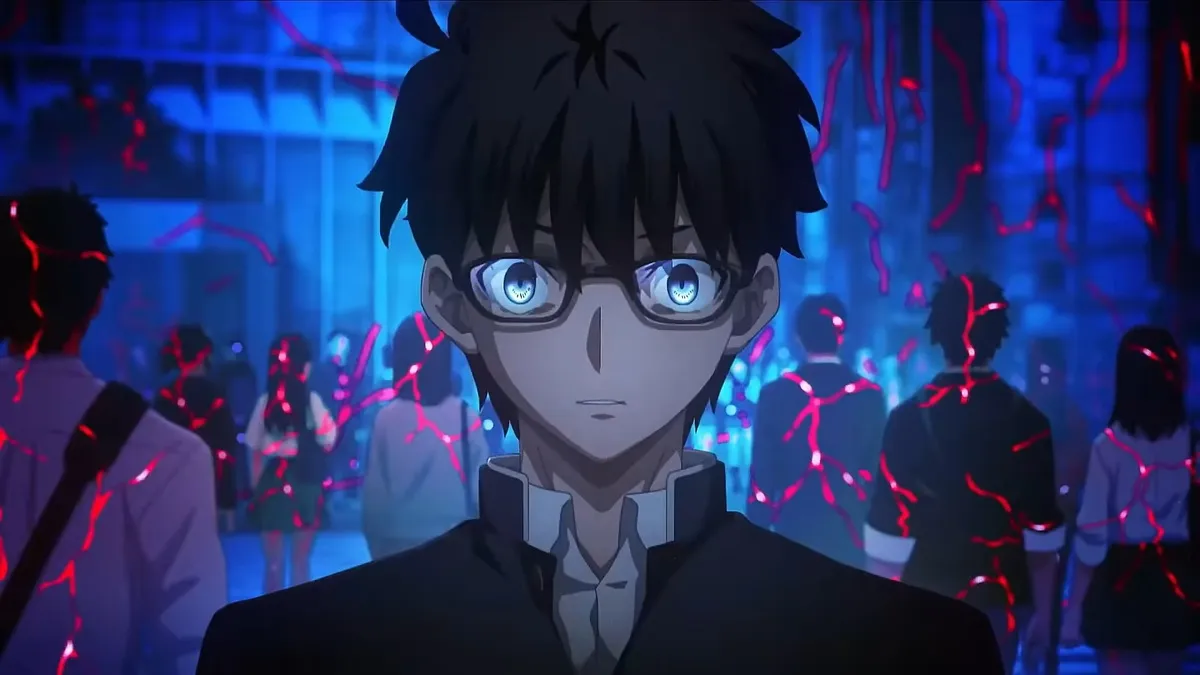
The plot of Tsukihime: A piece of blue glass moon follows Shiki Tohno, whose family disowned him seven years prior to the main story after suffering through a near-fatal accident. Among the aftereffects is his ability to see “lines” that exist in the world and even on people. Cutting through these lines, even with something as dull as a plastic knife, can cause them to break apart. Thankfully, young Shiki received a pair of glasses that prevented him from seeing the lines in his day-to-day life. Since then, he managed to live as an ordinary student. That is, until his family called him back to the Tohno mansion following the death of his father.
However, a chance encounter with a mysterious woman—Arcueid—on the street pulls Shiki into the supernatural conflicts that are occurring in his city, yet outside of the perception of ordinary people. For example, the serial killer murdering hapless women and draining their blood every night is actually a vampire,. Meanwhile, another vampire is in pursuit of them. People he thought were normal civilians—including himself—have a hidden connection to these magical beings and wars. It’s everything that you might expect from this genre of urban fantasy, though with a horror bent to it.
For reference, I did not play the original game myself. I watched my friend play through Tsukihime as a kid, though the language barrier prevented me from understanding it. I knew the general gist of it after getting into Type-Moon thanks to online translations, as well as the anime. So because of that, I couldn’t tell which parts of the story were from the original and which were new additions. I could tell that scenes with the new characters were new (of course), as were references to more modern technology or media that didn’t exist back in 2000. Personally, I didn’t find the addition of the new characters to be very jarring. They fit into the overall lore and story very well. In fact, if I didn’t know better, I’d be under the impression they’ve always existed in Tsukihime.
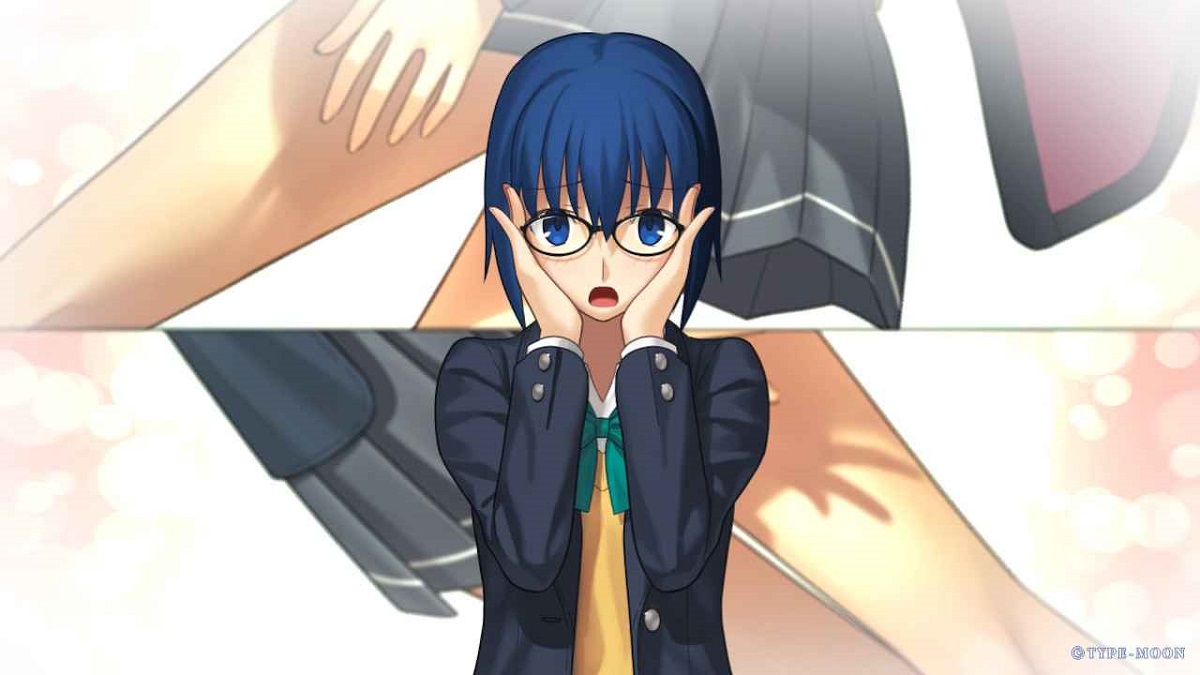
I personally really liked the story in Tsukihime! It feels like a good look at the Nasuverse as a whole, especially compared to more contained stories like Witch on the Holy Night. The chemistry between the characters was really nice, though I enjoyed Ciel’s route more than Arcueid’s. I was hard-pressed to really dislike characters, but I found Arach the least tolerable. Her voice actress (Mamiko Noto) did a great job portraying her. But the combination of her character design, her way of talking, and her word choices were pretty vile. Speaking of Arach, her design really drew my attention to the way that some of the female characters’ breasts are drawn. Their apparent lack of a bra at times was distracting and not in a good way. I’m sure it’s meant to titillate male players, but as someone with breasts, I kept thinking, “They don’t work like that!”
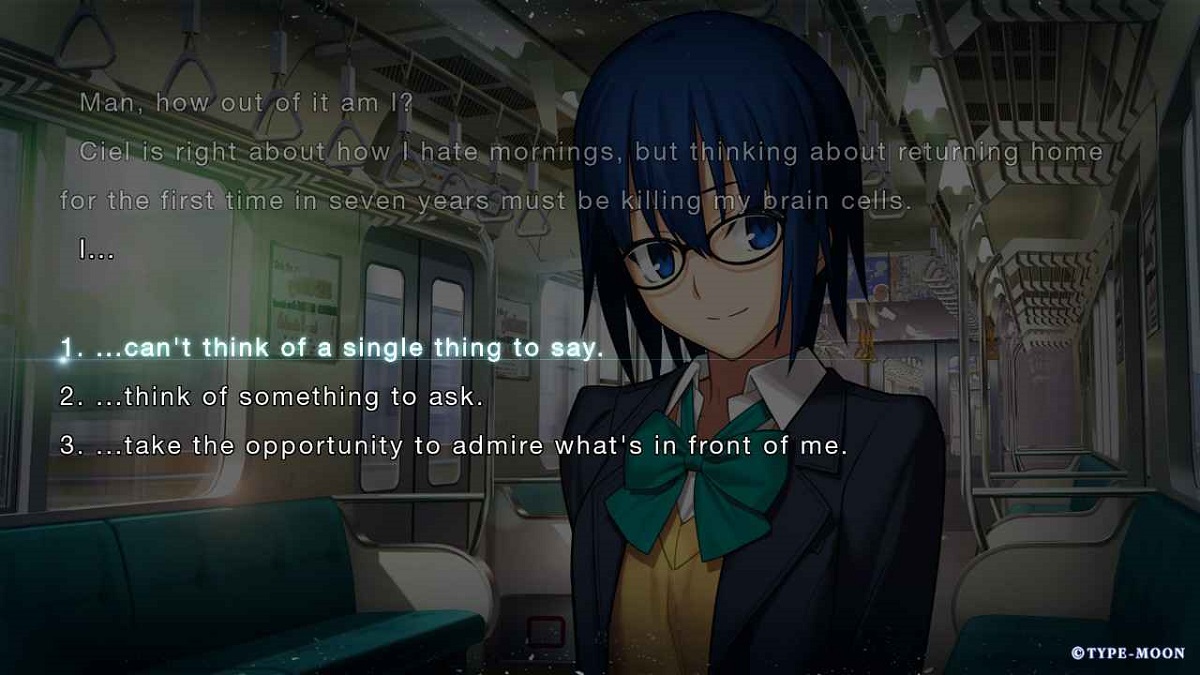
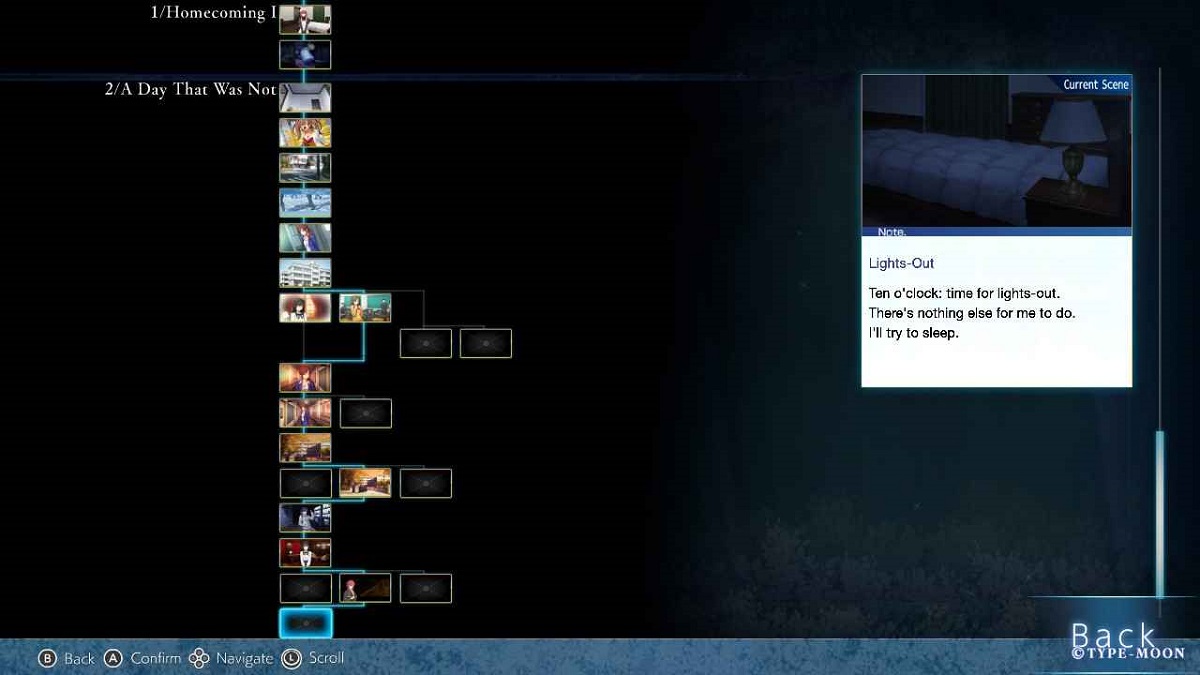
As for the gameplay, it’s a visual novel with several routes and endings. At times, you’ll need to choose between several options. You can check back at any time in the flowchart what you chose at certain scenes. Some scenes have prerequisites. For example, you need to make Mio scold you when you’re with Ciel on the train to unlock another event later. Some endings might lead you to a dead end, in which case a humorous section with Miss Ciel and Neco-Arc will help you figure out what you needed to do instead. Of course, you could also be like me and kill Shiki on purpose in order to see more of this comedy duo. It added a level of replayability that I appreciated, since it was fun to explore and look for the different possibitilies and conversations.
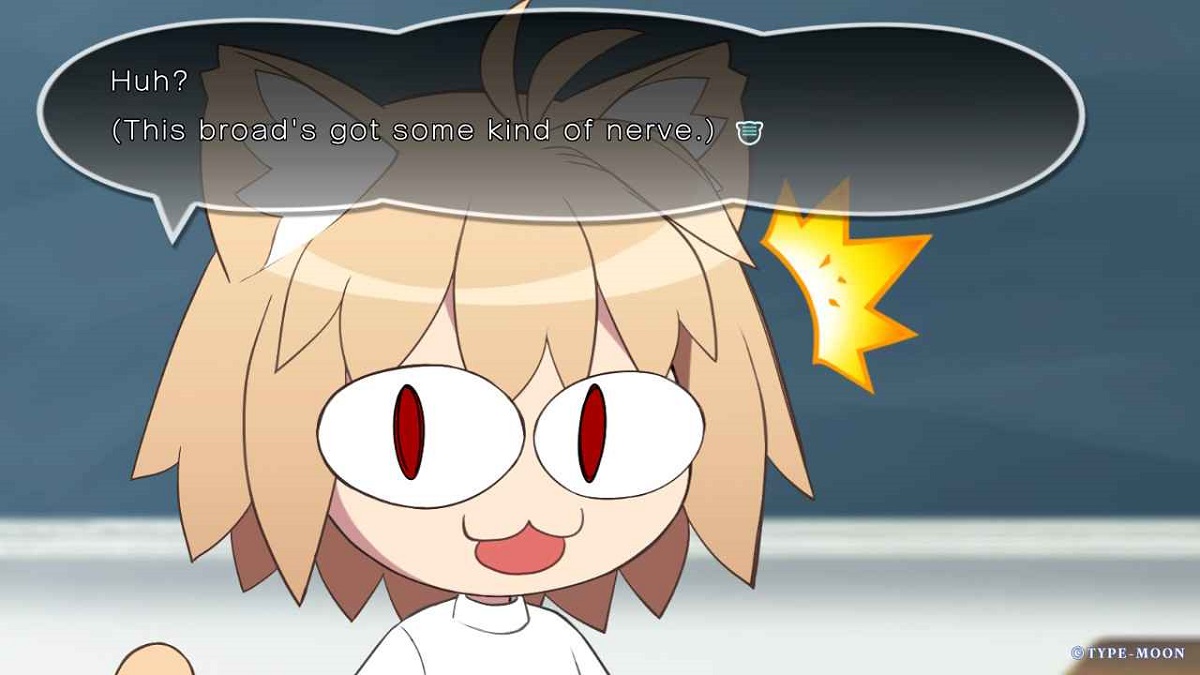
In my review for Witch on the Holy Night, I noted that while the game’s presentation and story were fantastic, the localization felt rushed. That issue does not persist in Tsukihime: A piece of blue glass moon. There are barely any typos or unnatural phrasing, barring ones that people would expect from Nasu’s writing. It definitely felt like the localization team gave the translators and editors more time to perfect the translation, and the end result was worth it. Even without the kinetic format of the visual novel, it was easy to lose myself in the snappy conversations, poetic descriptions, and heart-pounding action.
This isn’t anything to do with the localization team, as I believe that the Japanese version did the same thing, but something to watch out for is in the prologue. To convey the confusion and trauma of the scene, the voice over and the text that appears on screen don’t match up. I think this is on purpose in order to show how jumbled the character’s thoughts are. However, there aren’t any translations that appear for the voice-over. Unfortunately, no one has posted a Let’s Play of the remake version of Tsukihime: A piece of blue glass moon and I can’t go back to check the prologue even after starting a new game. So I can’t double check what the text on screen was in Japanese.
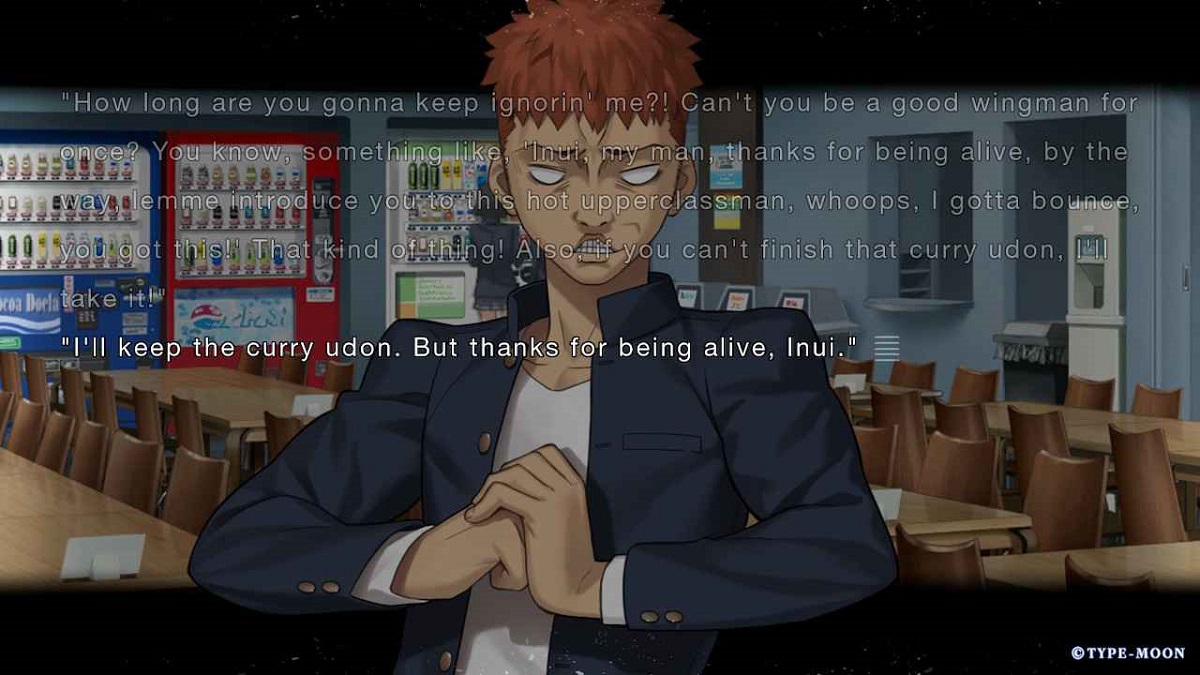
The one thing that I think Witch on the Holy Night did better is accessibility. Tsukihime: A piece of blue glass moon was not an easy read at times. In comparing my screenshots with Witch on the Holy Night, the backgrounds and characters felt more transparent. So when the text appeared over the artwork, it was legible without much strain. In docked mode, sometimes the text would meld into the backgrounds or characters. It’s much better in handheld mode. Either they need to make the screen between the text and the artwork more opaque, or they need to raise the transparency on the artwork when there’s text above it. Hopefully this is an issue unique to the Switch; it would be dreadful if PS4 players have to just deal with it on a bigger screen.
Tsukihime: A piece of blue glass moon is a great entry game for new Type-Moon fans and a fantastic remake for old ones. Though players can dive right in without A Witch on the Holy Night, I do recommend playing that one first if you haven’t! It helps to further your understanding of the story and world. The explanations and narration from Shiki’s point of view make it a really easy story to digest, as new fans of Nasu’s works might feel daunted by how complex the in-universe systems can be. The magic of Nasuverse is on full display in this beautiful remake, and it’s my new recommendation for those who want an action-packed visual novel.
Tsukihime: A piece of blue glass moon will come out for the PS4 and Nintendo Switch on June 27, 2024.
After a grievous injury in his childhood, Shiki Tohno was sent away to live in a relatives' house from a young age. Upon being called home after the death of his father, he began to live with his little sister and two maids in the lavish Tohno mansion. While living a normal life as a high schooler, he has a chance encounter with a monster in human flesh. Thus starts his conflict with the other supernatural beings roaming around his hometown of Souya. Switch version reviewed. Review copy provided by company for testing purposes.
Tsukihime: A piece of blue glass moon is a beautiful game with an amazingly rich story, colorful cast of characters, and a smooth localization.
- I really hope to see news on the Far Side routes soon. The Tohno mansion characters get plenty of screentime, but obviously the spotlight was on the main vampire stuff, Arcueid, and Ciel.
- You can play however you want, but I found it easier to just get through the story first and then go back to collect the different dialogue options and paths through the flowchart.
- I booted up Fate/Grand Order and finished building Arcueid after playing Tsukihime. Though I liked Ciel's route more, that doesn't mean I disliked Arcueid's.


Published: Jun 26, 2024 11:01 am